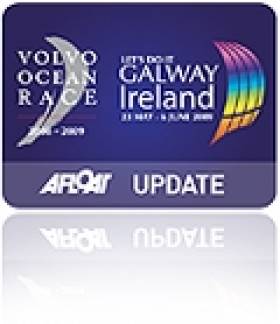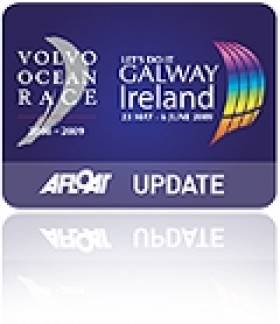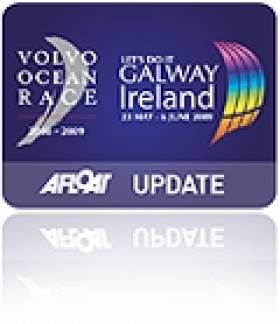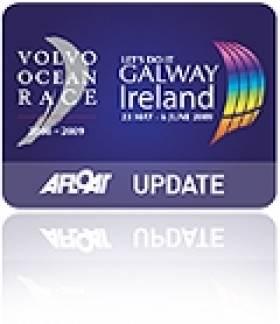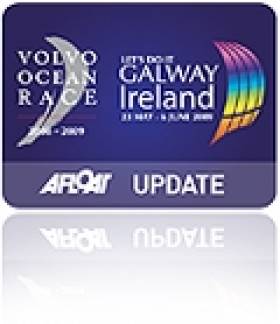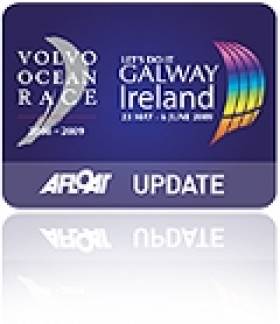Displaying items by tag: Volvo
Team Sanya Takes Third in Qualifying Race
This qualifier race, which will not see any points awarded, was intended to act as a 'dry run' for the teams and Volvo Ocean Race organization to test safety procedures ahead of the 39,000 nautical mile Volvo Ocean Race, which starts with the Alicante in-port race on October 29th.
The teams experienced the full range of conditions on this short 350 mile trip, from light winds to start with, thunderstorms and 30 knot gusts during the night, to near total becalming towards the end of the race.
Team Sanya, navigated by Aksel Magdahl, took the southerly route around Ibiza on the return leg back to Alicante and was rewarded the best of the breeze, along with Telefonica and Puma. Camper, Groupama and Abu Dhabi Ocean Racing opted for the northern route and suffered from the lack of wind, dropping back despite all of them having been in the lead of the race at some stage.
Telefonica, skippered by Olympic Gold medalist Iker Martinez, crossed the line at 05.45.24 UTC, Puma at 06.48.54 UTC and Team Sanya at 09.15, Camper and Groupama are yet to finish as we issue this report.
Cameron Dunn, Watch Captain on Team Sanya, commented on the highs and lows of this qualifier race,
"We are very pleased with this result, it was a tough and long race with not much sleep for any of us. We made a few errors tactically to start with and then got a few calls right later on but that's all part of the learning curve. It was strange to race without Mike (Sanderson) on board but actually very good for the team and we learnt a lot – we probably made a few more mistakes that we would have made if he had been there, but that's all part of the experience. A good result for Team Sanya."
Aksel Magdahl, Navigator on Team Sanya, explained the tactical challenges as a navigator during the race,
"There was certainly plenty of action and we had every type of condition thrown at us, just like a mini Volvo leg all in 36 hours! We had to make a call on which side to pass the Island of Ibiza and lost out on the way up, initially we gained but then we lost out. We then had a big thunderstorm, massive 30 knot squall and huge shifts so we had a bit of sorting out to do after that, but got going again. The choice to go south of Ibiza on the way back was the right one for sure, we could see the boats to the North parked up and headed south to benefit from better breeze. It was a great experience to do this race, good to shift from practice to race mode."
Finally, Tiger (Teng Jiang He) Grinder/Trimmer, added his views on this qualifier race,
" A very tough race with little sleep. We started with an upwind leg where we must have done around 100 tacks so it was tiring, we had some losses but then overtook Groupama and pushed on forward. The windy night challenged us again with a lot of action on board and finally we finished in no wind. Very exciting and great to be racing."
The Team Sanya race boat is lifted out of the water today, for four days of official measurement ashore.
Sea Sickness Rules Irish Sailor Out of World Race
Galway sailor Frankie Leonard is stepping down as Team Sanya's media crew-member following a bout of seasickness in the recent 2,000-mile qualifying passage for the Volvo Ocean Race (VOR).
The team Sanya entry is a Chinese-Irish entry in the race that starts in November from Alicante. Tourism body Discover Ireland are backing the boat and making up 25% of its estimated €10 milion campaign costs. Leonard was the only Irish crew member on the boat that is under Kiwi skipper Mike Sanderson, a former race winner. The boat, one of seven entries, is expected at the race finish in Gawlay next July.
A statement yesterday described the development as a "cruel blow" to both Leonard and the campaign and paid tribute to the cameraman's commitment and contribution.
Much of the MCM role is dependent on being below decks for extended periods, either working in the tight confines or at the galley preparing the freeze-dried food for the crew and is a mandatory position within every team. The team statement is below.
23rd Sept 2011
Mike Sanderson, Team Sanya CEO and Skipper, announced yesterday with regret a change to the media crew member role following a decision to release Frankie Leonard from his duties. Frankie, who has been engaged with the team since the beginning of the project, unfortunately has suffered from seasickness, which affects a great many sailors.
Mike Sanderson commented:
" Frankie has all of the ideal qualities to fit this role - superb teamwork and communication skills, a dynamic approach to his film and photo work combined with a great sense of humour and a pleasure to be around. However, this race is all about performance on the water and Frankie's suffering from seasickness is a cruel blow both to the team and to him. As anyone who been struck down by seasickness knows well, it can leave you incapable of functioning to your normal levels. We have 37,000 miles of ocean to cover and sadly that left me with no option in this matter.
Frankie has made a great contribution to the team and made many new friends in the time he has been here and we will be keeping in touch for sure."
Frankie Leonard added his thoughts:
"It has been an amazing opportunity to be a part of this special team and a great experience both personally and professionally. I am happy to say that I leave with no regrets. It is always unfortunate when things come to an end but rather than dwell on negatives I prefer to accentuate positives. Team Sanya has had one of the highest media outputs of all the teams with almost double some teams output for video, blogs and photos. We have steadily built up good relationships with the media, our sponsors and Volvo Ocean Race HQ, which can only be a positive for the team. I know that the skills, knowledge and experience I have acquired will stand to me as I now go in search of new projects. I am glad to count Mike and my teammates as good friends now and I wish Team Sanya a safe, happy and fast race."
Dun Laoghaire Yacht Clubs Voice Concern Over Plan
Dun Laoghaire Yacht Clubs are voicing concerns about the impact on sailing if a 'cruise ship jetty' is constructed as part of the recently published harbour masterplan.
Dublin Bay Sailing Club, Dun Laoghaire Motor Yacht Club, National Yacht Club, Royal Alfred Yacht Club
Royal Irish Yacht Club and Royal St George Yacht Club. are also concerned about access to the water if a proposed 'pedestrian walkway' in front of the waterfront clubs was completed.
The clubs have engaged 'professional help' to prepare a submission to outine the concerns.
Also seen as a problem is the 'lack of sufficient facilities in the masterplan for hosting significant international sailing events'.
A survey in 2009 by the Irish Marine Federation (IMF) calculated a €3million spend by participants connected with the 500-boat Volvo Dun Laoghaire regatta. The clubs have previously stated they see the harbour's future as a leisure facility.
A masterplan model was on display by the Harbour Company in the month of August.
Writing to members in the current edition of the National Yacht Club's newsletter commodore Paul Barrington says the clubs 'hope to further engage with the harbour [company] to find a mutually acceptable way forward'.
Water Rat: Harbour Plan is a Curate's Egg
Dublin to Hamble in 24 Hours - Team Sanya's Video
One minute it's trips round the bay with Miss World, canapés at the Royal Irish Yacht Club and corporate hobnobbing in Dun Laoghaire. The next it's a wet and windy ride from Dublin to Hamble in 24 hours. It's the lot of the modern Volvo Ocean Race crew (helmets compulsory). Chinese-Irish race entry Team Sanya boss Mike Sanderson (a previous race winner) has called his exit from Dublin 'heinous'. Don't take our word for it tho, check his vid below:
Rosanna Davison Goes Sailing on Team Sanya (Pics here!)
Former Miss World Rosanna Davison went sailing from Dun Laoghaire today on board the Chinese Volvo Ocean Race Yacht, Team Sanya. The yacht has backing from discover Ireland and is on a promotional day before departing for Alicante and next month's race start. Kiwi Skipper Mike Sanderson showed the local girl the ropes and Photographer Michael Chester sent Afloat.ie back these photos from the high speed spin around Dublin Bay.
Skipper and past race winner Mike Sanderson and his crew - including Galway’s Frankie Leonard – received a special send-off from Rosanna who won her Miss World title in the Chinese city of Sanya in 2003.
Team Sanya is the Chinese entry in the 2011-12 Volvo Ocean Race, a 40,000-mile round the world race that will finish in Galway on the 3rd July 2012. A special relationship developed between Ireland and China during the last race through the Green Dragon entry.
Rosanna boarded the yacht at 11.00am at the Royal Irish Yacht Club and sailed with the team into Dublin Port. The Eastlink bridge was lifted at 2.00pm, and Team Sanya docked beside the Cill Airne.
As part of the team’s promotion and it’s Irish link through the Discover Ireland.com, the 70 foot race boat and crew will head back out into the open sea as they start their journey to Alicante for the race start on the 5th November.
The Volvo Ocean Race is regarded as sailing’s premier global race and one of the most demanding team sports in the world. The 2011-2012 Volvo Ocean Race route is: departing on 5th November from Alicante to Cape Town (South Africa) Abu Dhabi (UAE) Sanya (China) Auckland (New Zealand) Itajai (Brazil) Miami (USA) Lisbon (Portugal) Lorient (Framce) and finally Galway on the 3rd July 2012.
Mike Sanderson, skipper and CEO of Team Sanya commented on the forthcoming trip: “Our relationship with Ireland is really important to us. Frankie Leonard from Galway is our media crew member and he is going to be paramount in telling our story as we race around the world, building the profile of Ireland as the stunning tourist destination that it is. For many of our team, it is our first time visiting Ireland so we were really happy to include a pitstop in Dublin during one of our training trips.”
Frankie Leonard, Team Sanya race team and the Irish Media Crew Member, added: “As the only Irishman on board I’m very proud to be part of this exciting event with Team Sanya and really looking forward to sailing into Dublin next week. My home town is Galway and finishing there in July 2012 is going to be a very special moment but this stop-over is a perfect way to help build a strong following and fan base in Ireland to develop Ireland’s profile as we travel to nine other ports around the world.”
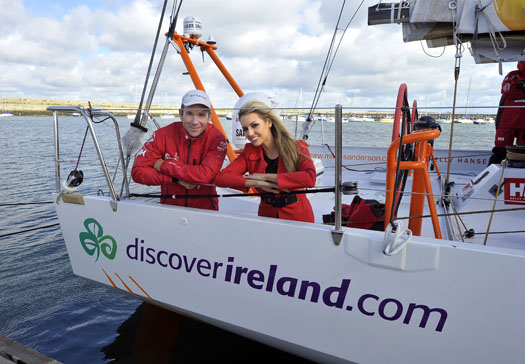
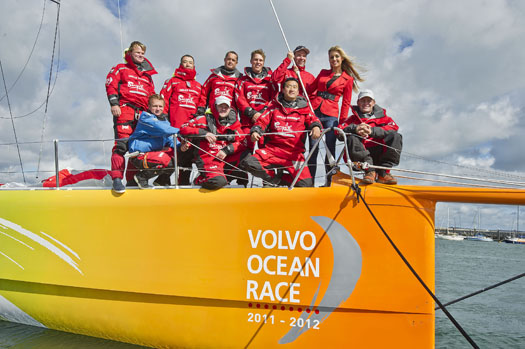

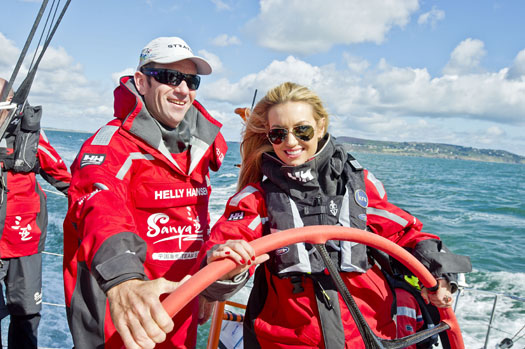
More shots of Team Sanya on Dublin Bay today (by Gareth Craig) here
Rosanna Davison Goes Back to Her Roots Sailing with Team Sanya
Skipper and past race winner Mike Sanderson and his crew - including Galway's Frankie Leonard - will receive a special send-off from Rosanna who won her Miss World title in the Chinese city of Sanya in 2003.
Team Sanya is the Chinese entry in the 2011-12 Volvo Ocean Race, a 40,000-mile round the world race that will finish in Galway on the 3rd July 2012. A special relationship developed between Ireland and China during the last race through the Green Dragon entry, say backers Discover Ireland, the tourism body.
Rosanna will board the yacht at 11.00am at the Royal Irish Yacht Club and will sail with the team into Dublin Port. The Eastlink bridge will lift at 1.00pm, and Team Sanya will dock beside the Cill Airne at 2.00pm. Rosanna will be on the Cill Airne from 5.30-7.00
As part of the team's promotion and it's Irish link through the Discover Ireland.com brand, the race boat and crew will call into Dun Laoghaire on Sunday, 4th September, at 5pm as previously reported on Afloat.ie.
They will overnight in Dublin and sail up the Liffey on Monday at 1pm and dock beside the MV Cill Airne on North Wall Quay, Dublin 1. A reception will be held on the MV Cill Airne from 5-7pm.
At 7pm the Team will head back out into the open sea as they start their journey to Alicante for the race start on the 5th November.
The Volvo Ocean Race is regarded as sailing's premier global race and one of the most demanding team sports in the world. The 2011-2012 Volvo Ocean Race route is: departing on 5th November from Alicante to Cape Town (South Africa) Abu Dhabi (UAE) Sanya (China) Auckland (New Zealand) Itajai (Brazil) Miami (USA) Lisbon (Portugal) Lorient (Framce) and finally Galway on the 3rd July 2012.
Mike Sanderson, skipper and CEO of Team Sanya commented on the forthcoming trip: "Our relationship with Ireland is really important to us. Frankie Leonard from Galway is our media crew member and he is going to be paramount in telling our story as we race around the world, building the profile of Ireland as the stunning tourist destination that it is. For many of our team, it is our first time visiting Ireland so we were really happy to include a pitstop in Dublin during one of our training trips."
Frankie Leonard, Team Sanya race team and the Irish Media Crew Member, added: "As the only Irishman on board I'm very proud to be part of this exciting event with Team Sanya and really looking forward to sailing into Dublin next week. My home town is Galway and finishing there in July 2012 is going to be a very special moment but this stop-over is a perfect way to help build a strong following and fan base in Ireland to develop Ireland's profile as we travel to nine other ports around the world."
Volvo 70 Team Sanya Heading for Dun Laoghaire
The Volvo Ocean Race Chinese entry, Team Sanya, backed by Discover Ireland, is coming to Dublin Bay this Sunday afternoon. She will berth alongside the Royal Irish Yacht Club according to the promoters. At 4pm the Mike Sanderson skippered boat will round a turning mark off Dun Laoghaire harbour before berthing in the port. Team Sanya is a refurbished version of the Telefónica Blue boat from the 2009 race.
Green Dragon Sailing for Kinsale then Rotterdam
Galway's round the world yacht, the Volvo 70 Green Dragon, sailed from Galway Port this morning. Her first port of call is Kinsale and on Thursday she will sail for Rotterdam.
From there she will go on a low-loader for Frankfurt to become a static exhibit rather than a sailing craft. She is to appear at the world famous Frankfurt Motor Show where Galway owners say 'she will be put on display in a premier position' - fully rigged - promoting the Volvo Ocean Race 2011 - 2012 and the Race finish in Galway as part of a global village exhibtion showcasing Irish innovation, food and the marine.
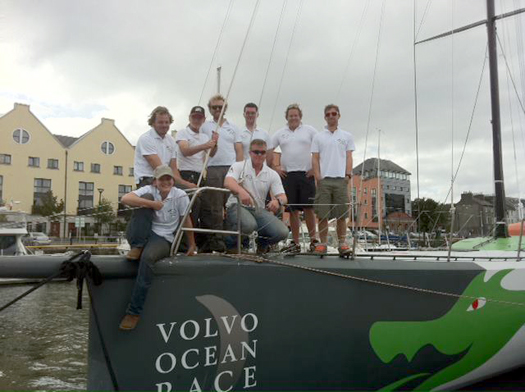
The Green Dragon crew who are enroute for Rotterdam via Kinsale
"At this major global exhibition in Germany this will be a fantastic opportunity to showcase Irish Sailing and our plans for 2012 - and also to show our support for Team Sanya our Chinese Irish Volvo Ocean Race Team. A formal send off is planned from Dublin for Team Sanya on Monday 5th Sept", says Enda O'Coineen of Let's Do It Global, who is sailing on the first leg of the voyage to Frankfurt.
Piracy Threat Forces Volvo Ocean Race Route Change
The escalating piracy problem in the Indian Ocean has forced organisers of the Volvo Ocean Race 2011-12 to redraw the routes for the second and third legs.
The boats were due to have sailed through an East African corridor in the Indian Ocean on the second leg from Cape Town to Abu Dhabi and again in the third leg from Abu Dhabi to Sanya in China but after taking advice from marine safety experts and the sport's governing body, the International Sailing Federation (ISAF), the routes have been changed.
The boats will now race from Cape Town to an undisclosed 'safe haven' port, be transported closer to Abu Dhabi, and then complete the leg from there. The process will be reversed for the third leg before the race continues on to Sanya.
"This has been an incredibly difficult decision," said Volvo Ocean Race Chief Executive Knut Frostad. "We have consulted leading naval and commercial intelligence experts and their advice could not have been clearer: 'Do not risk it.'
"The solution we have found means our boats will still be racing into Abu Dhabi and competing in the in-port race there.
"Abu Dhabi is a very important part of our plans, a real highlight being the race's first-ever stopover in the Middle East, and we will now have a really exciting sprint finish to the emirate over the New Year period as well."
Abu Dhabi will host the race from December 30 to January 14 with a purpose-built race village at its Corniche waterfront site and a headline New Year's Eve concert amongst various festivities set to provide a spectacular welcome to more than 100,000 visitors.
"The measures taken by the Volvo Ocean Race are very much in line with the advice that the International Sailing Federation has been giving for some time." said ISAF Secretary General Jerome Pels. "The ISAF strongly urges all yacht skippers intent on sailing anywhere in the area to seek an alternative, which the Volvo Ocean Race is now providing."
Three Volvo 70s Start the Fastnet Race (Pics here)
One of the most impressive sailing sights from the weekend was on the Solent yesterday when three Volvo Ocean Race 2011-12 entries Groupama Sailing Team, Abu Dhabi Ocean Racing and current leader Team Sanya started the Rolex Fastnet Race, the first full blooded test of the boats in the build up to October's start. Ireland has a sponsorship tie in with the Sanya entry and it also has an Irish media man onboard.



























